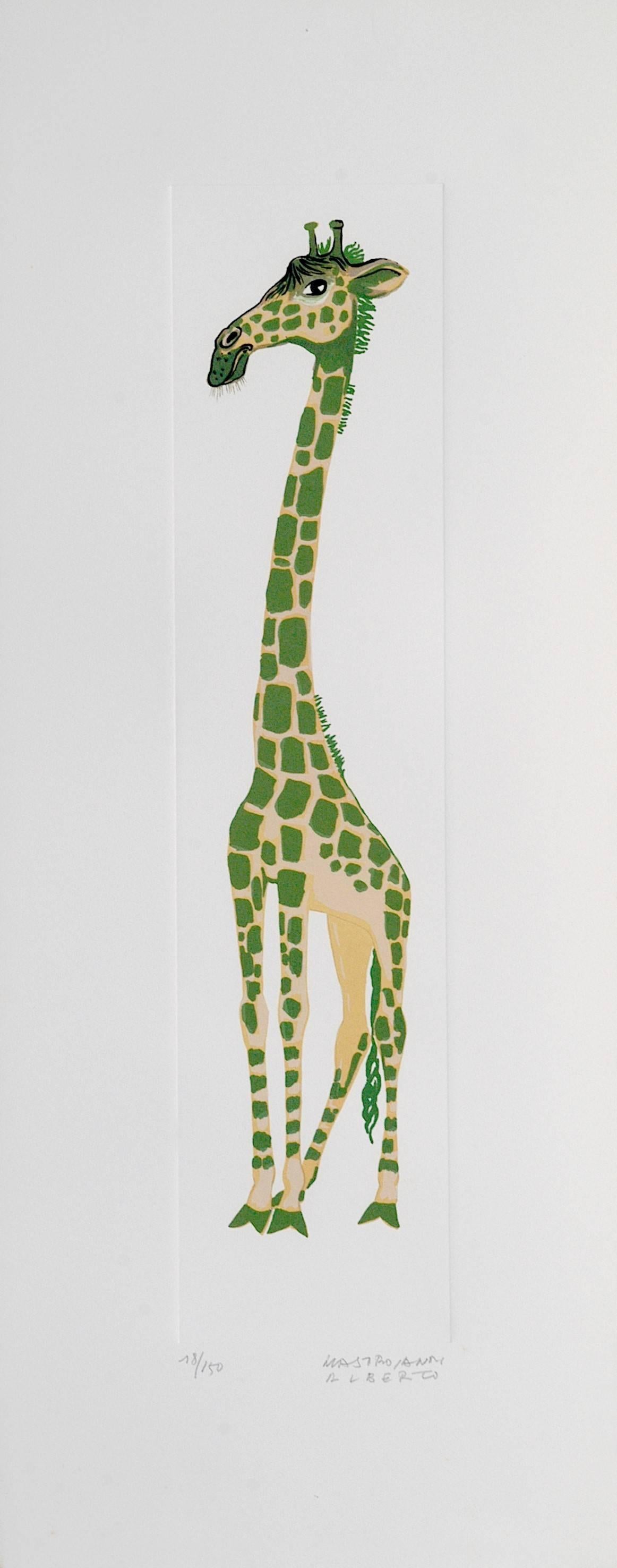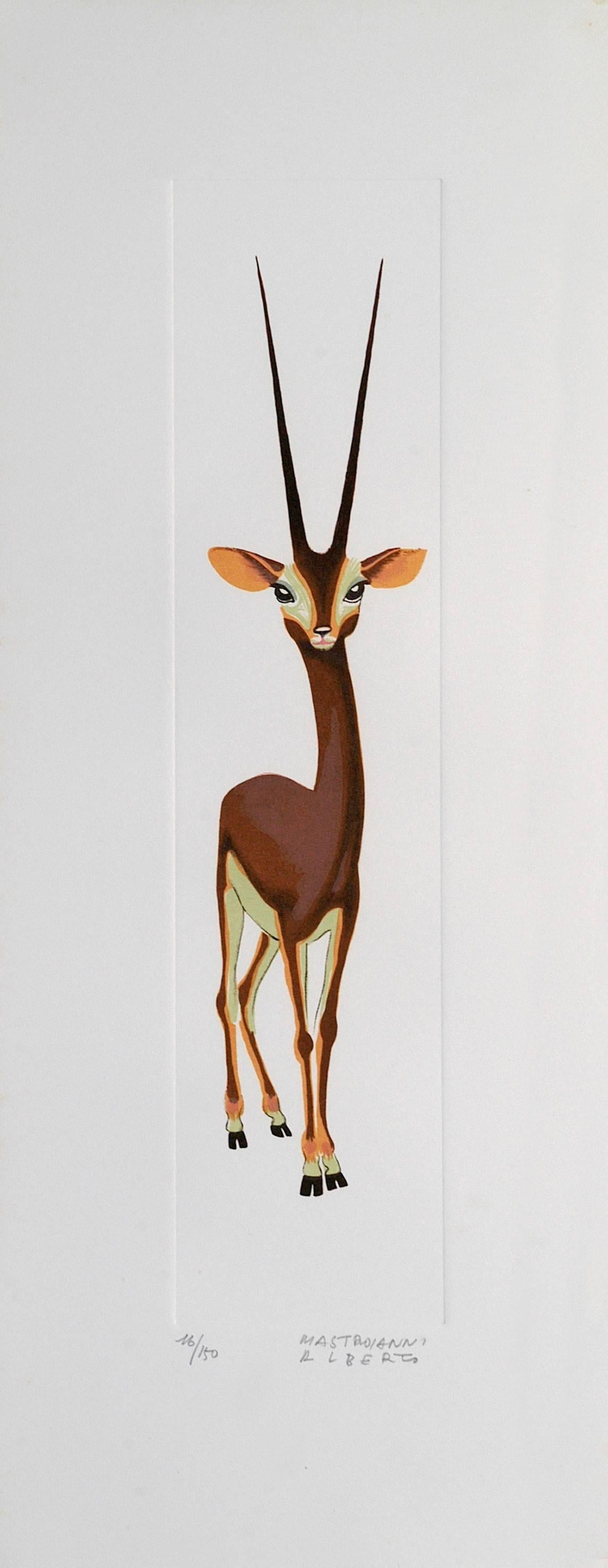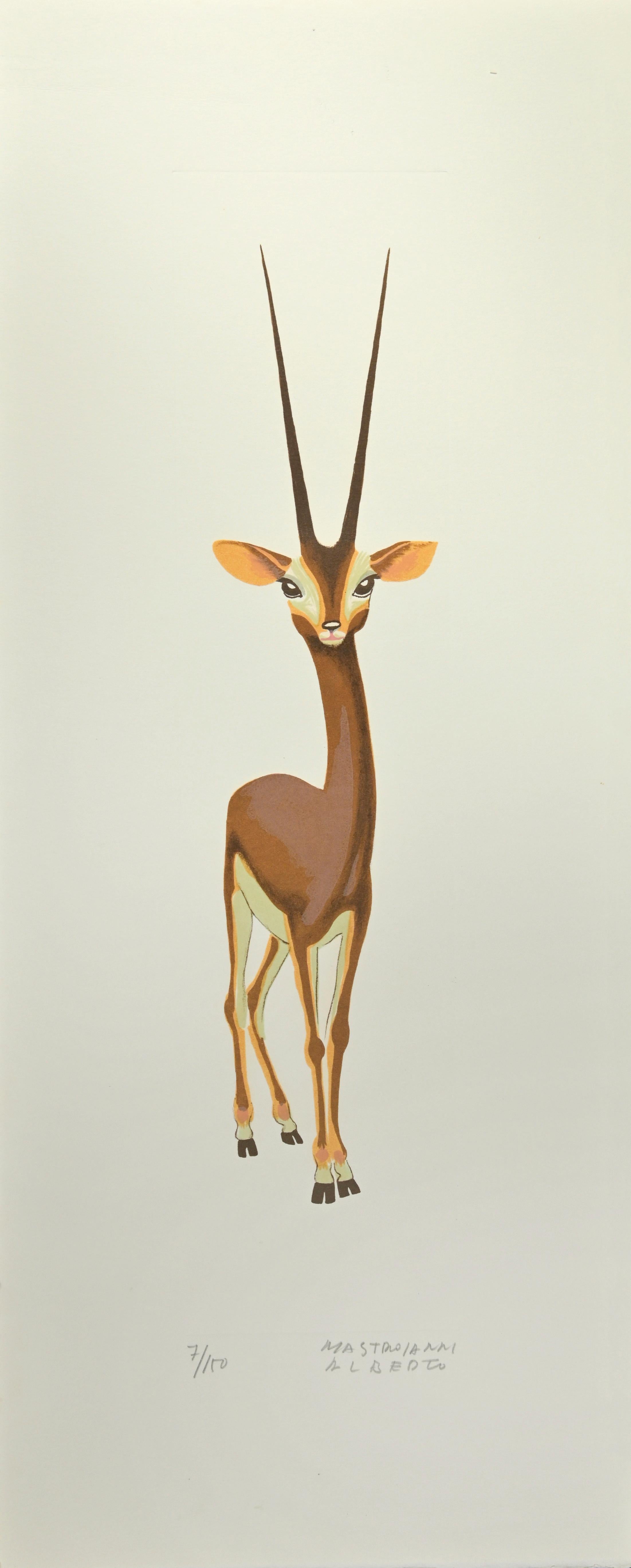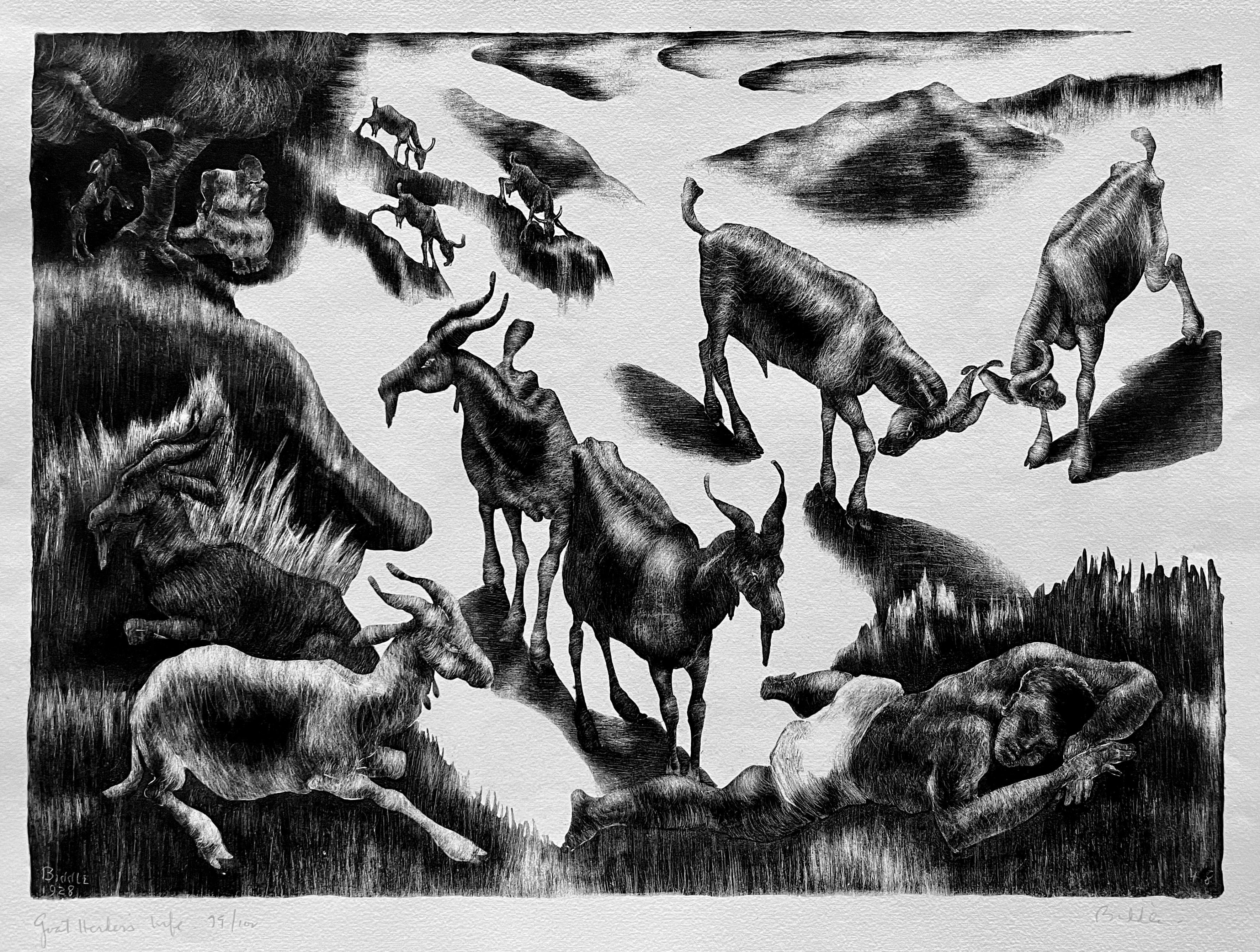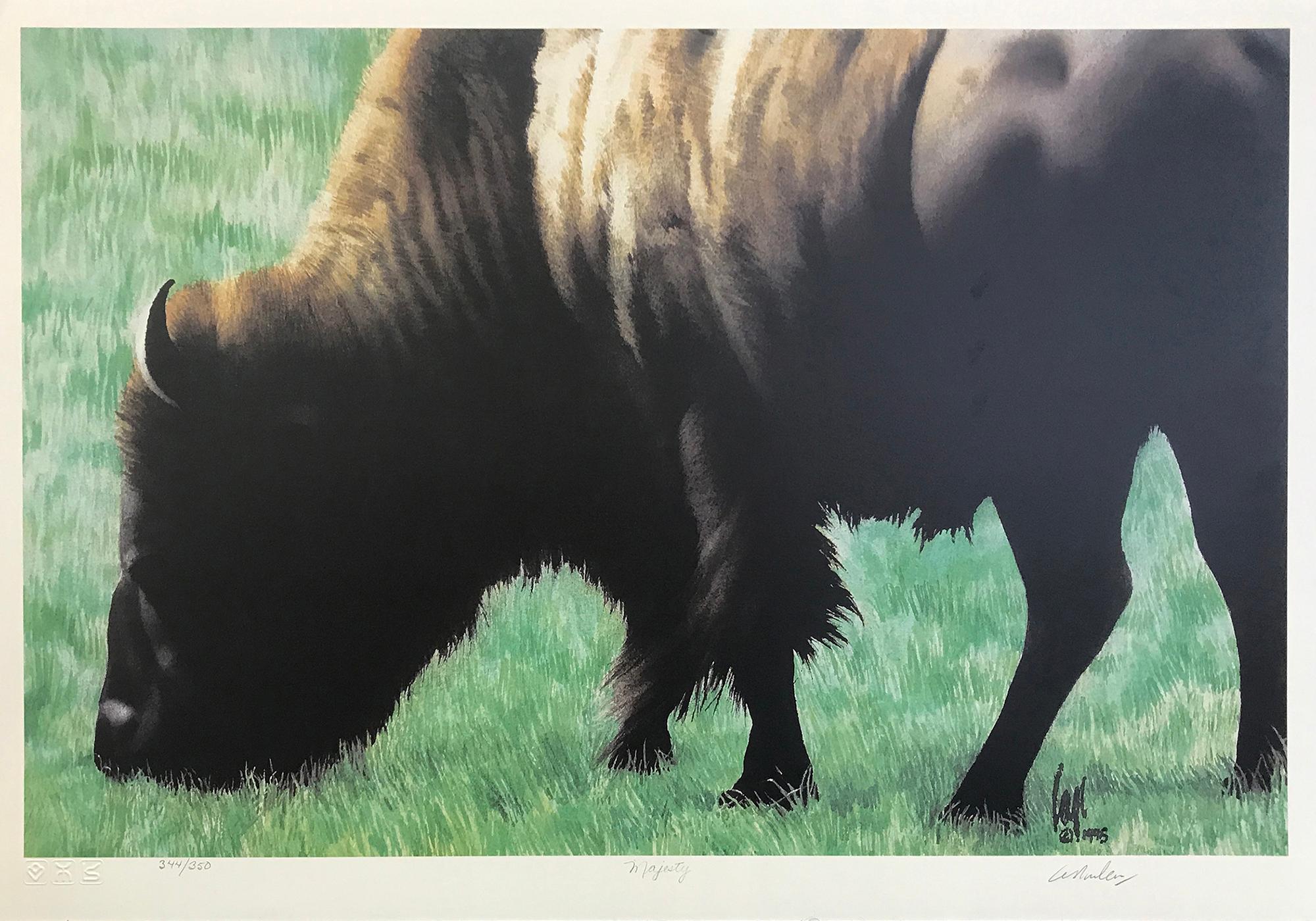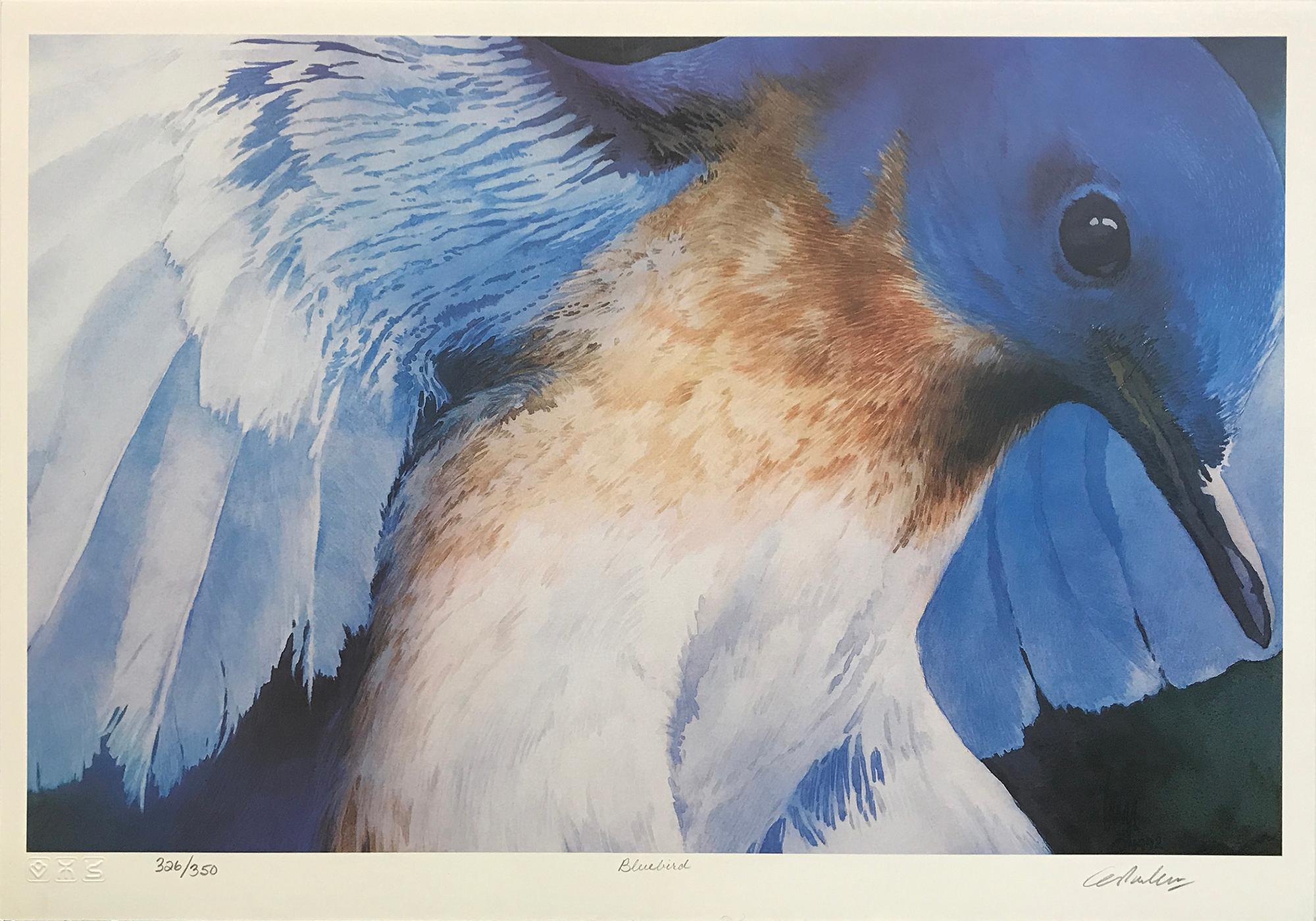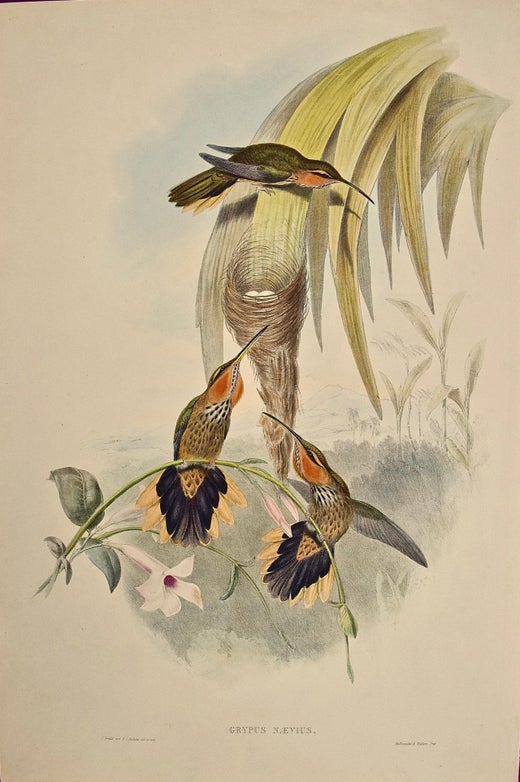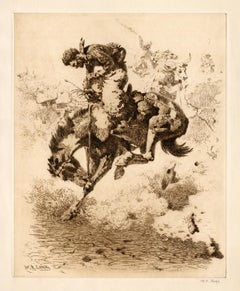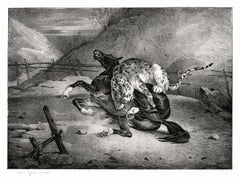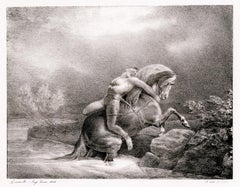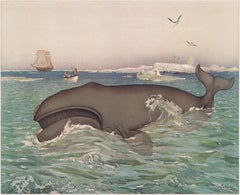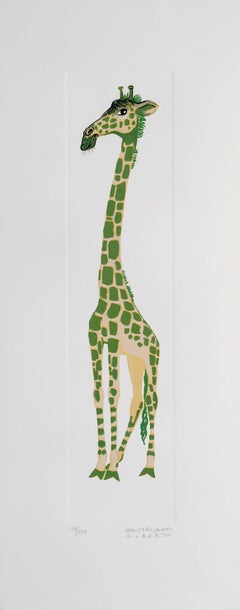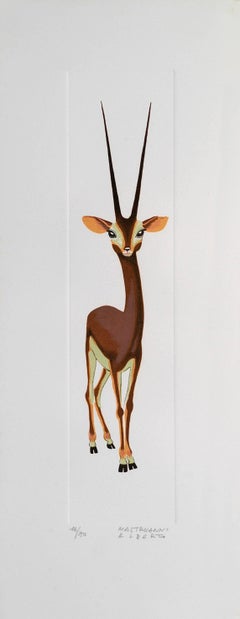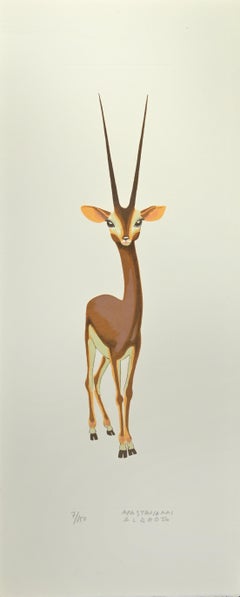Items Similar to Leucippus Fallax (Buffy Hummingbird) — Original Hand-colored Lithograph
Want more images or videos?
Request additional images or videos from the seller
1 of 7
John Gould and Henry Constantine RichterLeucippus Fallax (Buffy Hummingbird) — Original Hand-colored Lithographc. 1850
c. 1850
About the Item
John Gould, 'Leucippus Fallax' (Buffy Hummingbird), original lithograph with hand-coloring (not a reproduction), c. 1850. Signed in typeset 'J. Gould and H. C. Richter, del et lith.', lower left. A finely detailed lithographic impression with transparent oil paint hand-coloring and surface varnish for luminosity on cream wove paper; the full sheet with wide margins. Several small spots of foxing (shown in the full-sheet image), minor glue stains in the left and right top sheet edge, verso (from previous hinges); otherwise in very good condition. Matted to museum standards, unframed.
Image size 12 x 10 1.4 inches; sheet size 21 3/8 x 14 1/4 inches.
From ‘A Monograph of the Trochilid, or Family of Humming-birds in Five Volumes’ v. 3, Printed by Taylor and Francis; published by John Gould, 1849, London.
Impressions of this work are held in prominent public collections, including Amherst College, Arts Council England, Australian Museum (Sydney), College of Charleston, Cornell University, Glasgow Libraries (University of Glasgow, Scotland), Royal Collection Trust ( Buckingham Palace, London), State Library of Victoria (Australia), and the Smithsonian Libraries and Archives (Washington DC).
ABOUT THE ARTIST
John Gould maintained an obsessive fascination for hummingbirds throughout his life: "These wonderful works of creation my thoughts are often directed to them in the day, and my night dreams have not infrequently carried me to their native forests in the distant country of America."
John Gould (1804 –1881) was born in England, on the Dorset coast but was brought up in Surrey and later Windsor, where his father was one of the gardeners at the castle. The young Gould taught himself taxidermy from an early age and soon established a skill for the craft. Following a brief 18-month stint as a gardener at Ripley Hall in Yorkshire, in 1824, he moved to London to establish a shop in the city.
The taxidermy enterprise was successful and Gould counted important public figures, including George IV (for whom he stuffed a pet giraffe in 1826), among his clients. In 1828, he won a competition to become taxidermist at the Museum of the Zoological Society of London and eventually became the curator of the museum, where he developed connections with some of the most prominent naturalists of the day and received specimens from around the world to preserve and prepare for display. He was also noted for his own knowledge of ornithology and, in 1836, assisted Charles Darwin in understanding the specimens collected from the Beagle voyage to the Galapagos, demonstrating that the birds collected were not different species as Darwin initially thought but varieties of the same species, thus inspiring his revolutionary theory of natural selection.
Gould began to publish fine ornithological volumes in 1830. They are among the most famous and important 'bird books' of the nineteenth century, and the volumes in the Royal Library were subscribed to by Prince Albert and Queen Victoria.
Gould's passion was for hummingbirds. Though not seeing one alive until a specially arranged trip to the United States in 1857 specifically for that purpose, he collected over 1,500 different birds from across 300 species, going so far as to display them to the public at the Zoological Garden of the Great Exhibition in 1851. Between 1849 and 1861, Gould published his most beautiful work, '‘A Monograph of the Trochilid, or Family of Humming-birds', containing finely painted illustrations of these tiny birds based upon the stuffed specimens in his collection. The major achievement of Humming-birds is the inclusion of gold leaf under the colouring to replicate the iridescence of the animals' plumage. The practice was not new; naturalists painting watercolor over gold leaf to show iridescence in feathers and in the scales of fish since the beginning of the century. Gould learned the technique from correspondence with the American ornithologist William Lloyd Baily (1828-61). However, Gould's innovation, employed by Henry Richter, who painted many of the birds, was the use of oils and varnish instead of watercolors to produce a brilliancy never before seen on the page.
—excerpted from the introduction to the artist, Royal Collection Trust, Buckingham Palace, London
- Creator:John Gould and Henry Constantine Richter (1804 - 1881, English)
- Creation Year:c. 1850
- Dimensions:Height: 12 in (30.48 cm)Width: 10.25 in (26.04 cm)
- Medium:
- Movement & Style:
- Period:
- Condition:
- Gallery Location:Myrtle Beach, SC
- Reference Number:Seller: 1038861stDibs: LU53238162892
John Gould and Henry Constantine Richter
John Gould (1804-1881]) was an English ornithologist and artist. He, like his American contemporary John James Audubon, published a number of books on birds in the mid 19th century, illustrated by hand-colored lithographs. His wife and fellow artist, Elizabeth Gould, and several other artists including Edward Lear and Henry Constantine Richter produced lithographs for his various publications. He has been considered the father of bird study in Australia and the Gould League in Australia is named after him. Charles Darwin referenced Gould’s work in his book, "On the Origin of Species" and Gould named a bird after Darwin; "Darwin's finches". Gould began his career in London as a taxidermist, but in 1827 became the first curator and conservator at the museum of the Zoological Society of London. In this position naturalists brought him collections of birds from all over the world. He began creating drawings and eventually hand-colored lithographs with his wife and Edward Lear, which were the basis for his first publications. Darwin brought him specimens from the Galapagos Islands, including 12 species of finches which had never been described. In 1838, Gould and his wife travelled to Australia and their work led to the seven volume publication of “The Birds of Australia”. Gould had a fascination for hummingbirds and collected specimens of 320 varieties before ever seeing a live hummingbird on a trip to the United States in 1857. He eventually published “A Monograph of the Trochilidae, or Family of Humming-birds". Other large publications include: "The Birds of Europe"," A Monograph of the Ramphastidae, or Family of Toucans”, “A Synopsis of the Birds of Australia, and the Adjacent Islands”, “A Monograph of the Odontophorinae, or Partridges of America”, “The Birds of Asia”, “The Birds of Great Britain” and "The Birds of New Guinea and the Adjacent Papuan Islands, including many new species recently discovered in Australia".
About the Seller
5.0
Recognized Seller
These prestigious sellers are industry leaders and represent the highest echelon for item quality and design.
Platinum Seller
Premium sellers with a 4.7+ rating and 24-hour response times
Established in 1995
1stDibs seller since 2016
297 sales on 1stDibs
Typical response time: 1 hour
Associations
International Fine Print Dealers Association
- ShippingRetrieving quote...Shipping from: Myrtle Beach, SC
- Return Policy
Authenticity Guarantee
In the unlikely event there’s an issue with an item’s authenticity, contact us within 1 year for a full refund. DetailsMoney-Back Guarantee
If your item is not as described, is damaged in transit, or does not arrive, contact us within 7 days for a full refund. Details24-Hour Cancellation
You have a 24-hour grace period in which to reconsider your purchase, with no questions asked.Vetted Professional Sellers
Our world-class sellers must adhere to strict standards for service and quality, maintaining the integrity of our listings.Price-Match Guarantee
If you find that a seller listed the same item for a lower price elsewhere, we’ll match it.Trusted Global Delivery
Our best-in-class carrier network provides specialized shipping options worldwide, including custom delivery.More From This Seller
View All'Foul Rope (Left)' — Early American Southwest Rodeo
By William Robinson Leigh
Located in Myrtle Beach, SC
William Robinson Leigh, 'Foul Rope (Left)', etching, c. 1920, edition unknown but small. Signed in pencil and signed in the plate, lower left. A superb, richly-inked impression, in dark brown ink, on buff wove Umbria paper, the full sheet with margins (1 1/2 to 2 3/4 inches); slight toning at the sheet edges, otherwise in excellent condition. Very scarce. Archivally matted to museum standards, unframed.
Image size 14 7/8 x 11 15/16 inches (378 x 303 mm); sheet size 20 3/8 x 15 3/8 inches (518 x 391 mm).
ABOUT THE ARTIST
Born near Falling Waters, West Virginia, on a plantation a year after the Civil War and raised in Baltimore, William Robinson Leigh (1866 - 1955) became one of the foremost painters of the American West. His career spanning some seventy-five years, Leigh created some of the most iconic depictions of the Western landscape, with admirers referring to him as ‘The Sagebrush Rembrandt.’
The son of impoverished Southern aristocrats, Leigh received his first art training at age 14 from Hugh Newell at the Maryland Institute, where he was regarded as the best student in his class. From 1883 to 1895, he studied in Europe, mainly at the Royal Academy in Munich with Ludwig Loefftz. From 1891 to 1896, he painted six cycloramas or murals in the round, a giant German panorama.
In 1896, Leigh began working as a magazine illustrator for Scribner's and Collier's Weekly Magazine in New York City. He also painted portraits, landscapes, and genre scenes.
Leigh's trips to the Southwest began in 1906 when he agreed to paint the Grand Canyon with William Simpson, Santa Fe Railway advertising manager, in exchange for free transportation West. In 1907, he completed his Grand Canyon painting, which led to more commissions and an extensive painting trip through Arizona and New Mexico. These travels inspired him to paint western subjects for the next 50 years, and his primary interests were the Hopi and Navajo Indians.
In 1910, he traveled to Wyoming, where he painted in Yellowstone Park and created sketches, many of which he later converted into large canvases such as ‘Lower Falls of the Yellowstone’ (1915) and ‘Grand Canyon of the Yellowstone’ (1911).
In 1926, he traveled to Africa at the invitation of Carl Akeley for the American Museum of Natural History, and from this experience, wrote and illustrated 'Frontiers of Enchantment: An Artist's Adventures in Africa'. In 1933, he wrote and illustrated 'The Western Pony'. His adventures were chronicled in several popular magazines, including Life, the Saturday Evening Post, and Colliers.
For many years, Grand Central Art Galleries at the Biltmore Hotel handled his work exclusively in New York. In 1953, Leigh was elected an associate member of the National Academy of Design and became a full Academician in 1955.
In March 1999, the Historical Center of Cody, Wyoming, held an exhibition of his field sketches and finished works depicting his experiences near Cody early in the century. Between 1910 and 1921, when he often painted in the Carter Mountain vicinity, these years were considered pivotal to his artistic development and devotion to the Western landscape.
Leigh's work is held in many museum collections of American Western art...
Category
1920s Realist Animal Prints
Materials
Etching
'Horse Attacked by Tiger' — 19th-Century French Romanticism
By Jean Louis Andre Theodore Gericault
Located in Myrtle Beach, SC
Théodore Géricault (after), 'Tigre dévorant un cheval' (Tiger Devouring a Horse), lithograph, 3rd state of 3, Clement 97, c. 1820. Lettered 'Volmar ...
Category
1820s Romantic Animal Prints
Materials
Lithograph
'Mazeppa' — 19th-Century French Romanticism
By Jean Louis Andre Theodore Gericault
Located in Myrtle Beach, SC
Théodore Géricault and Eugène Lami, 'Mazeppa' from the series 'Oeuvres de Lord Byron', lithograph, 1823, 2nd state of 3, Delteil 94. Rendered by Thé...
Category
1820s Romantic Animal Prints
Materials
Lithograph
Whaling – Vintage Monumental Zoology Lithograph
Located in Myrtle Beach, SC
Joseph Fleischmann, 'Whaling' (Hartingers Wandtafeln: Zoologie T. XXXII), monumental vintage color lithograph, 1900. Signed in the matrix, lower right. A superb, beautifully nuanced impression, on cream wove paper, the full sheet with margins (1 1/2 to 2 3/16 inches), in very good condition. Sheet size 28 x 38 1/2 inches (711 x 978 mm). The full sheet, unmounted and unmatted—shipped carefully rolled and protected.
Rendering by A. Berger after Joseph Fleischmann. Published by Carl Gerold’s Son, Vienna, 1900.
This Artic whaling scene depicts a Greenland whale in the foreground pursued by whalers. A whaling ship is seen in the background and at right, another whale among icebergs with seagulls overhead. The print by Albert Berger...
Category
Early 1900s Naturalistic Animal Prints
Materials
Lithograph
$1,125 Sale Price
25% Off
'Bighorn' — Mid-Century American Regionalism
Located in Myrtle Beach, SC
William Wind McKim, 'Bighorn', lithograph, 1940, edition c. 25. Signed and titled in pencil. A fine, richly-inked impression, on cream wove paper, the full sheet with margins (2 to 4...
Category
1940s American Realist Animal Prints
Materials
Lithograph
$600 Sale Price
20% Off
'Pups in the Pit' — American Realism
Located in Myrtle Beach, SC
William Wind McKim, 'Pups in the Pit', lithograph, 1967, edition c. 50. Signed and titled in pencil. A fine, richly-inked impression, on cream wove paper, with full margins (1 1/8 to...
Category
1940s American Realist Animal Prints
Materials
Lithograph
You May Also Like
Giraffe
By Alberto Mastroianni
Located in Roma, IT
Hand Signed. Edition of 150 prints.
Category
1970s Realist Animal Prints
Materials
Lithograph
Gazelle - Lithograph by A. Mastroianni - 1970s
By Alberto Mastroianni
Located in Roma, IT
Hand Signed. Edition of 150 prints in Arabic numbers plus 30 prints in roman numbers.
Excellent conditions.
Category
1970s Realist Animal Prints
Materials
Lithograph
Gazelle - Lithograph by A. Mastroianni - 1970s
By Alberto Mastroianni
Located in Roma, IT
Hand Signed. Edition of 150 prints in Arabic numbers plus 30 prints in roman numbers.
Excellent conditions.
Category
1970s Realist Animal Prints
Materials
Lithograph
Goat Herder's Wife
By George Biddle
Located in New York, NY
George Biddle (1885-1973), Goat Herder’s Wife, 1928, lithograph, signed in pencil lower right and titled and numbered (64/100) in pencil lower left margin [with the inscription ”Bidd...
Category
1920s Realist Animal Prints
Materials
Lithograph
MAJESTY
By Carl Arlen
Located in Aventura, FL
Lithograph on paper. Hand signed, titled and numbered by the artist. Edition of 350. Artwork is in excellent condition. Certificate of Authenticity is included. All reasonable off...
Category
Late 20th Century Realist Figurative Prints
Materials
Lithograph, Paper
$150 Sale Price
25% Off
BLUE BIRD
By Carl Arlen
Located in Aventura, FL
Lithograph on paper. Hand signed, titled and numbered by the artist. Edition of 350. Artwork is in excellent condition. Certificate of Authenticity is included. All reasonable off...
Category
Late 20th Century Realist Figurative Prints
Materials
Lithograph, Paper
$150 Sale Price
25% Off
